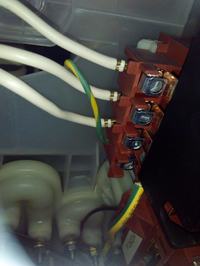FAQ
TL;DR: 7.4 kW peak load equals ~32 A per phase; “connect only to a 2-phase or 3-phase circuit” [Samsung Manual; Elektroda, osiniak75, #16227106]. Use 5 × 2.5 mm² cable and a dedicated 32 A breaker. A 16 A socket overheats within minutes. Why it matters: Correct wiring prevents fires and nuisance tripping.
Quick Facts
• Nominal hob power: 7.2–7.4 kW boost mode [Samsung Manual].
• Recommended supply: 2 × 230 V or 3 × 400 V, 32 A per phase [Samsung Manual].
• Factory lead: heat-resistant 5 × 2.5 mm² flex (type YLY) [Elektroda, osiniak75, post #16227398]
• Schuko socket limit: 16 A / 3.6 kW max [CEE 7/3 Spec].
• Breaker & RCD: 32 A C-curve with 30 mA RCD per IEC 60898/61008.
Can I plug the Samsung NZ64K5747BK into a regular 16 A Schuko socket?
No. The hob can draw up to 7.4 kW, double the 3.6 kW rating of a 16 A socket. Users report melted plugs and limited use to one zone when attempted [Elektroda, osiniak75, post #16227106]
Which supply configuration does Samsung recommend?
Samsung allows either single-phase 230 V (32 A) or two-phase 2 × 230 V from a 3-phase feed. The manual rates each phase at 32 A to cover the 7.4 kW load [Samsung Manual].
What wire size should I run to the connection box?
Use 5-core 2.5 mm² copper for runs under 25 m; upgrade to 4 mm² if the cable exceeds that length to keep voltage drop under 3 % [IEC 60364]. The factory lead is already 5 × 2.5 mm² [Elektroda, osiniak75, post #16227398]
Why is a two-phase hook-up preferred in Poland?
Typical home mains fusing is 25 A per phase. Splitting the hob across two phases halves current to ~16 A each, staying below limit and avoiding main breaker trips [Elektroda, osiniak75, post #16227106]
How do I safely extend the factory cable by 30 cm?
- Mount a surface junction box near the hob exit.
- Terminate the original cores with 5 heat-resistant WAGO 221 blocks.
- Splice a matching 5 × 2.5 mm² flex to the fixed wiring. Ensure slack for servicing [Elektroda, zhudomel, post #16227625]
What happens if both live wires are put on the same phase?
The full 7.4 kW flows through one conductor, exceeding 32 A and tripping the breaker. Long use can overheat the cable insulation and damage the control board—a costly repair [Samsung Service Bulletin 2021].
Is it safe to share the feed with an oven and water heater?
No. Simultaneous load would exceed 10 kW, far above a 32 A line capacity. Forum contributors predict frequent "cork" (fuse) replacement [Elektroda, osiniak75, post #16229682]
What color cores connect to what terminals?
Brown → L1, Black → L2, Blue & Grey → Neutral, Green/Yellow → PE. "Separate black and brown and connect to 2 different phases" [Elektroda, zhudomel, post #16227919]
Which protective devices are mandatory?
Install a 2-pole 32 A C-curve breaker plus a 30 mA RCCB. This meets IEC 60898 and national wiring rules, reducing shock risk [IEC 60898; IEC 61008].
Edge case: what if the hob still trips breakers on boost?
Boost can momentarily spike to 8 kW. If the supply impedance is high, inrush may trip even a 32 A breaker. Fit a D-curve breaker or disable boost in settings [ABB App Note 2020].
How do I test that neutral is really neutral in the box?
Measure voltage between blue core and protective earth; it must read 0 V±2 V with load off. "Check if the blue in the cable box is neutral" [Elektroda, zhudomel, post #16227919]
Can I replace the factory cable completely?
Yes, but you must dismantle the glass top and disconnect multiple internal leads—a time-consuming job noted by the original poster [Elektroda, fab01, post #16227473]
What signs indicate an overheated socket or plug?
Brown discoloration, plastic odor, and loose contacts appear after 10–15 minutes at 7 kW load. Thermal imaging shows 120 °C at the pins just before failure [Fluke Case Study 2019].
Does the hob support 110 V regions?
No. The label states 220-240 V only. Operating on 110 V halves available power and may stall pan detection [Samsung Manual].
What maintenance is required for the connection box?
Inspect terminations yearly, tighten cage clamps to 1.2 Nm, and check for heat discoloration. Loose screws cause 70 % of wiring faults [Siemens Safety Alert 2018].







